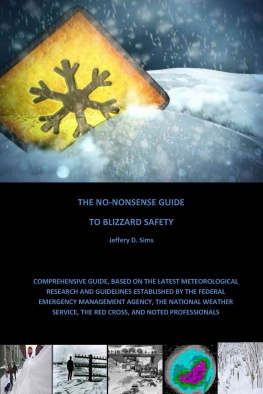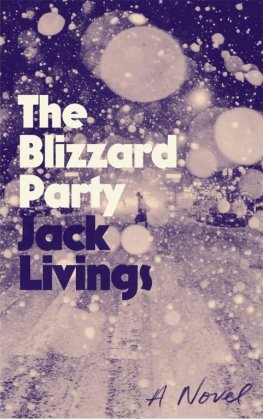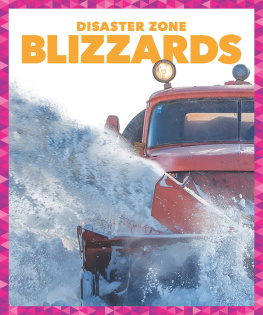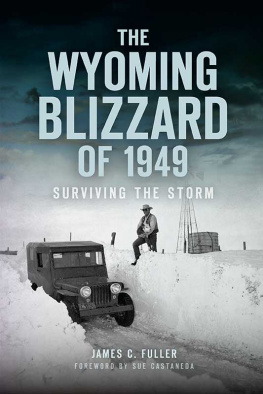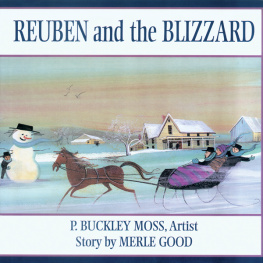Acknowledgement
The following is a list of the people Id like to thank for believing in me and my dreams:
(no, I didnt skip anyone).
Blizzards
What Are They?
The term blizzard is the applied description of a particular type of severe winter weather snowstorm. A blizzard is characterized by the presence of strong sustained winds of 35 mph (56 km/h) or higher, cold temperatures, and visibility reduced by falling and/or blowing snow to less than 1/4th of a mile (less than 400 m). Additionally, the criteria of high winds and reduced visibility must be sustained for 3 consecutive hours for a snowstorm to be considered an official blizzard. However, these are but the minimum-level criteria for what constitutes one of these severe winter storms; in most blizzards, the individual conditions tend to far exceed the set minimal. The winds of most blizzards routinely howl in excess of the 35mph (56 km/h) threshold, while low visibility due to falling and blowing snow is usually of a longer duration than 3 hours. The temperatures during a blizzard can fall well below 0 degrees Fahrenheit (-17 Celsius). This is especially true in blizzard-prone regions around the world.
Blizzards, especially severe blizzards can and often do create life-threatening conditions. For example, traveling by automobile in these storms can become difficult (or even impossible) due to reduced or near-zero visibility and rapidly accumulating snow amountssetting up the perfect conditions for calamities on the roads. Also, the strong winds and cold temperatures accompanying blizzards can combine to create dangerously unhealthy wind chills (the lowering of air temperatures caused by blowing wind as it affects the rate of heat-loss from the human body from exposed skin). Whats more, people have died attempting to remove the heavy amounts of snow after a blizzard has passed. Finally, the conditions involving a blizzard can hinder or even prevent emergency and rescue personnel from helping those who may need life-or-death assistance during one of these extreme snowstorms, resulting in possible prolonged injuries and/or death. This is because blizzards tend to brings most normal activity in areas where they occur to a standstill due to the impeding of traffic and other related travel. Under these circumstances, blizzards can impact a regions short-term economic stability by restricting or even halting day-to-day commerce-related activities. In worst-case scenarios, blizzards can cause property damage and inflict widespread casualtiesespecially in underdeveloped regions of the world where they might occur.

The aftermath of a 2011 blizzard in Chicago, Illinois. The city of Chicago is well-known for harsh winter weather and the occasional blizzard.

Above: The damage left in the wake of a Blizzard in the city of Boston, Massachusetts (Courtesy of CBS television, Boston). Below: The aftermath of the 2008 Afghanistan Blizzard, among the deadliest on record (aliraqi.org).

How Do They Form?
Like many other examples of extreme weather, blizzards require a particular set of atmospheric conditions as well as specific weather ingredients to come together in order to form. The conditions involving the formation of blizzards tend to congregate within the influence of the jet stream, the river of strong air currents that flow high in the atmosphere that influence the Earths climatic patterns.
Generally, a blizzard starts high in the clouds with tiny super-cooled water droplets (these water droplets can remain in this extreme cold state of all the way down to -40 Fahrenheit/-40 Celsius). While aloft, many of these droplets encounter particles of dust, also found in the air. As this happens, the super-cooled water droplets will freeze around these dust partials, forming ice crystals. At this point, random water vapor molecules begin to attach, collect, and grow as small lumps on each ice crystal. We recognize these lumps as the familiar and individually-unique geometric shapes of a snowflake, which forms around each dust particle.
Specifically, the atmospheric conditions needed for blizzards to form tend to do so around three individual elements, which need to be present for a blizzard to become active. The first of these is cold air. Freezing temperatures must be present both at ground level as well as in the clouds where snowflakes form. If warmer temperatures were present, particularly at ground level will cause any snow formed in the clouds to melt while falling to earth, resulting instead in either rain or freezing rain (liquid precipitation that forms and falls as raindrops that immediately freezes as it hits cold surfaces at ground-level). The second (and somewhat obvious) ingredient needed for blizzards to form is cloud-based moisture that eventually becomes precipitation. Moisture present in the air eventually combines with the proper temperature to form and provide the necessary water vapor that eventually becomes the signature heavy falling and blowing snow of blizzards. The final component needed for the creation of a blizzard isoddly enoughrising warmer air needed to create clouds and cause precipitation. This warm air must rise over the colder air, which may happen in 1 of 2 ways. The first way is for existing winds (such as jet streams) to pull colder polar air down toward warmer regions such as those found near closer to the equator, while bringing warmer air toward the poles from these warmer regions. The second way is when warmer air is sent aloft of colder air at higher elevations. As the warmer air rises, it forms clouds as it flows up a mountainside; the result is a rapidly forming mountaintop blizzard. For non-mountaintop blizzards, these ingredients will combine with a series of necessary conditions to create the setup for a blizzard.
For blizzards to develop, these [required] individual and general components become active within specific weather patterns that organize in colder weather. Blizzards tend to occur when the jet stream(s) in the upper atmosphere sags to the south, pulling polar air found in northern colder regions into warmer humid air to the south. The result is a clash of opposing air masses that often create high winds, not unlike those found at similarly intersecting air masses where spring thunderstorms form. Along this region of atmospheric instability, the presence of the increased moisture in the air, high winds, and the appropriate temperaturesthe aforementioned ingredientsstart the dynamics of a potential blizzard. When all of these conditions are present, the result is the driving winds and heavy and blowing snow we identify with blizzards.

An illustration of how warm and cold air interacts to form various forms of precipitation. The final stage of this diagram indicates the formation of a blizzards chief ingredient, snow.
And like all other weather occurrences, no two blizzards are alike. For example, snow stormsparticularly blizzardstend to produce a different brand of snow. Some snow is of the fluffy, powdery type. Powdery snow is composed of mostly. In fact, snowflakes making up this type of snow are made up of 95% air. And despite how much of this type of snow falls and blows during a blizzard, most snowflakes of this type never make it to the ground. But because this type of snow is lighter, it is easily blown around by high winds more readily, affecting visibility and creating dangerous conditions for those who find themselves outside during a blizzard. However, if a snowflake falls through a cloud with lower temperatures and humidity, thousands of super-cooled droplets will attach to its surface. This increased level of moisture within this type of snow makes it heavier. This type of heavy wet snow accumulates at a greater rate than the lighter, fluffy type. The result is usually higher snow totals with its own set of dangers.

